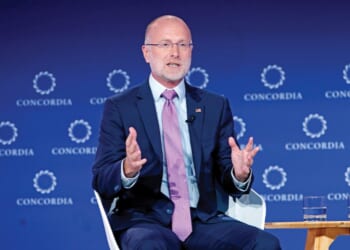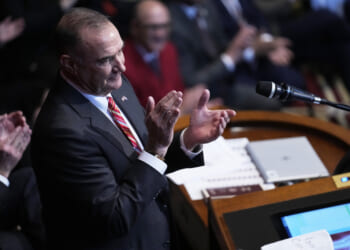Director of National Intelligence Tulsi Gabbard has released two emails that are significant not only for their content but for their timing, coming just two days before the Trump-Putin summit in Alaska. The emails reveal that in late 2016, then-DNI James Clapper pushed the fraudulent narrative that Russia had hacked the Democratic National Committee (DNC), overriding pointed objections from then-National Security Agency chief Admiral Mike Rogers.
The timing matters because this very narrative — the claim that Russia had hacked the DNC to help President Trump — was used to sabotage the 2018 Trump-Putin summit in Helsinki. Just three days before that meeting, Special Counsel Robert Mueller indicted 12 Russian nationals on charges of hacking the DNC. The indictment was designed to create political chaos. Mueller knew that the 12 Russians were located in Russia and would never stand trial, meaning he would never need to prove the case. The result of the indictments was exactly what Mueller, his team, and any yet-to-be-identified co-conspirators intended: to sabotage the summit and effectively criminalize diplomacy with Russia.
We all remember Helsinki, where, at the joint press conference standing next to President Putin, Trump addressed the alleged hacking directly:
“You have groups that are wondering why the FBI never took the server. Why haven’t they taken the server? Why was the FBI told to leave the office of the Democratic National Committee?”
What Trump meant was that no one could know what had happened because the key evidence — the DNC server — had never been examined by the FBI or any other U.S. government agency. Trump also noted that Putin had personally assured him, “It’s not Russia.” He then added his own assessment: “I will say this: I don’t see any reason why it would be [Russia].”
Trump was labeled a traitor for refusing to accept the Russian hack narrative without evidence. Even his own DNI at the time, Dan Coats, as well as many Republicans, publicly pushed back against him. As it turns out, Trump was absolutely correct, and the newly released emails from Gabbard now confirm that his skepticism was justified.
The latest emails show Clapper responding to Rogers’s doubts about the DNC hack narrative by saying, “that’s OUR story and we’re stickin’ to it,” adding that “more time is not negotiable” and “we may have to compromise on our ‘normal’ modalities, since we must do this on such a compressed schedule. This is one project that has to be a team sport.” Clapper needed the false DNC hack narrative included in the Intelligence Community Assessment, an Obama-ordered report aimed at blaming Trump’s election victory on Putin. Clapper advanced this narrative despite the actual intelligence saying otherwise.
The fact that Clapper was pushing a false narrative to undermine Trump is further corroborated by an earlier DNI report from 2016, released by Gabbard last month, which stated that the FBI and NSA “lack sufficient technical details to correlate the information posted online to Russian state-sponsored actors,” meaning there was no way to determine whether Russia had actually hacked the DNC.
The fact that the DNC hack, if it was indeed a hack as opposed to an internal leak, has never been resolved has much to do with how it was initially handled. When the issue first arose within the DNC, rather than calling in the FBI, the party relied on Clinton campaign lawyer Michael Sussmann to bring in a private cybersecurity firm, CrowdStrike. Whether this was done intentionally to advance the Russia collusion hoax is unknown.
What is clear is that Sussmann would later funnel a fabricated story about secret Trump-Putin communications via Russia’s Alfa Bank into the FBI. CrowdStrike quickly and very publicly proclaimed that Russian state actors were responsible. Conspicuously, the first such pronouncement came from co-founder Dmitri Alperovitch and Chief Security Officer Shawn Henry, who were cited in the Washington Post on June 14, 2016, claiming to have definitively identified Russian hacker groups working for the Russian government as responsible for the breach.
However, when Henry testified under oath in 2017 before the House Intelligence Committee, led at the time by Republican Devin Nunes, he admitted that CrowdStrike had “no direct evidence” that any data had been exfiltrated from the DNC servers. In fact, he could not even confirm there had been a hack. “There’s not evidence that they were actually exfiltrated,” Henry said, adding, “we just don’t have the evidence that says it actually left.”
Recent intelligence released by Sen. Chuck Grassley’s office shows that Russian intelligence services had intercepted emails of DNC chairwoman Debbie Wasserman Schultz, as well as two Soros Foundation operatives, discussing Clinton’s plan to smear Trump with Russia collusion and, notably, CrowdStrike’s role in pushing that narrative into the media.
The new release by Gabbard is a vindication for Trump, who stood alone in 2018 pushing back against the false narrative while nearly everyone else, including his own team, was fueling it. It strengthens Trump’s position ahead of the upcoming summit. No longer will he need to contend with fake hoaxes dominating the agenda. He can focus on the task at hand, bringing peace to Ukraine. The release also serves as an olive branch to Russia, effectively amounting to an admission by the U.S. intelligence community that it knowingly advanced a false claim, intended to undermine Trump and sabotage U.S.-Russian relations.
Lastly, one step that could be taken ahead of the summit is to terminate the Mueller indictment of the 12 Russians, which remains open. No one was ever going to stand trial. It was pure theatrics that did lasting damage to U.S.-Russia diplomacy, and dismissing the case would be a strong gesture to finally move the Trump-Russia collusion saga out of U.S. foreign policy.















